Most of us still feel a little rush of excitement when we wake up to see that it has snowed overnight. The sight of the world blanketed in soft white snow has the power to evoke childlike wonder no matter how old we are – until we realize that as adults, we still have to commute to work or get to the grocery store in such weather! Thankfully there are a number of steps we can take to make traveling in snowy and icy conditions safer, whether you’re driving, walking or using other modes of transportation. Here are some top tips.

Driving
The chance of getting into an accident is often higher when it snows, because your stopping distance is longer and visibility is reduced. Be sure to drive more slowly than you normally do, leave a greater distance between your car and other vehicles, and allow more time for your journey. If you live in an area that frequently experiences this kind of weather, it might be a helpful idea to look into cars good for snow, or invest in winter tires or snow chains to give you better grip on the road. You should always completely clear your car of snow before you set off, and keep some emergency supplies such as bottled water, food, a first aid kit, blankets and a flashlight in your vehicle just in case.
Cycling
Just like with driving, when cycling in snowy and icy conditions you should travel more slowly than usual and try to stick to routes that have been gritted or salted. Ensure you have lights on your bike, and dress in reflective clothing to help motorists spot you despite the reduced visibility. Plus you should wear plenty of layers (including gloves) to keep you warm. Avoid making sharp turns, and consider switching to wider, lower-pressure, or even studded tires. Lastly, regardless of the weather, always wear a cycle helmet.
Walking
It’s easy to slip and fall when walking on snow or ice, so try to wear shoes that have a good grip. Go slow, keep your center of gravity low, and make use of handrails when possible. You should avoid putting your hands in your pockets or using your cellphone when walking, and take extra care when going up or down stairs. If you can, try and stick to pathways that have been cleared or gritted. Finally, always wrap up warm when leaving the house in cold weather.
Taking public transport
Public transport is frequently delayed or canceled when the weather is particularly bad, so firstly consider whether your journey is absolutely necessary. If you do choose to travel, leave extra time to get to where you’re going, and take a book, some snacks and a bottle of water just in case you do get stuck on the train or at the station. Don’t forget that you may be entitled to compensation if your journey is delayed over a certain length of time, so keep hold of your ticket and check the company’s policy when you get home.
